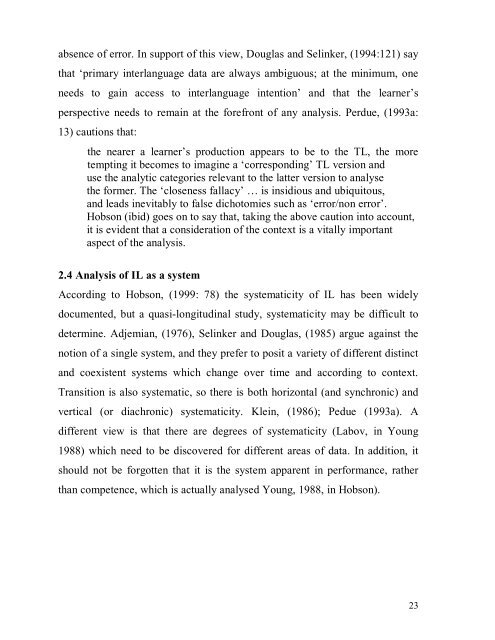error analysis: a study of errors committed by isizulu speaking ...
error analysis: a study of errors committed by isizulu speaking ...
error analysis: a study of errors committed by isizulu speaking ...
Create successful ePaper yourself
Turn your PDF publications into a flip-book with our unique Google optimized e-Paper software.
absence <strong>of</strong> <strong>error</strong>. In support <strong>of</strong> this view, Douglas and Selinker, (1994:121) say<br />
that ‘primary interlanguage data are always ambiguous; at the minimum, one<br />
needs to gain access to interlanguage intention’ and that the learner’s<br />
perspective needs to remain at the forefront <strong>of</strong> any <strong>analysis</strong>. Perdue, (1993a:<br />
13) cautions that:<br />
the nearer a learner’s production appears to be to the TL, the more<br />
tempting it becomes to imagine a ‘corresponding’ TL version and<br />
use the analytic categories relevant to the latter version to analyse<br />
the former. The ‘closeness fallacy’ … is insidious and ubiquitous,<br />
and leads inevitably to false dichotomies such as ‘<strong>error</strong>/non <strong>error</strong>’.<br />
Hobson (ibid) goes on to say that, taking the above caution into account,<br />
it is evident that a consideration <strong>of</strong> the context is a vitally important<br />
aspect <strong>of</strong> the <strong>analysis</strong>.<br />
2.4 Analysis <strong>of</strong> IL as a system<br />
According to Hobson, (1999: 78) the systematicity <strong>of</strong> IL has been widely<br />
documented, but a quasi-longitudinal <strong>study</strong>, systematicity may be difficult to<br />
determine. Adjemian, (1976), Selinker and Douglas, (1985) argue against the<br />
notion <strong>of</strong> a single system, and they prefer to posit a variety <strong>of</strong> different distinct<br />
and coexistent systems which change over time and according to context.<br />
Transition is also systematic, so there is both horizontal (and synchronic) and<br />
vertical (or diachronic) systematicity. Klein, (1986); Pedue (1993a). A<br />
different view is that there are degrees <strong>of</strong> systematicity (Labov, in Young<br />
1988) which need to be discovered for different areas <strong>of</strong> data. In addition, it<br />
should not be forgotten that it is the system apparent in performance, rather<br />
than competence, which is actually analysed Young, 1988, in Hobson).<br />
23
















